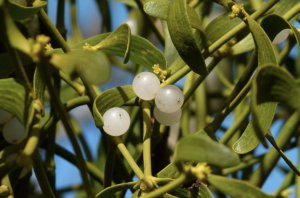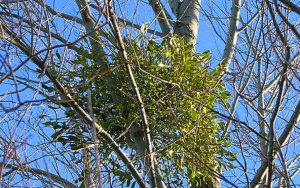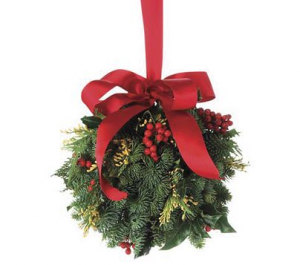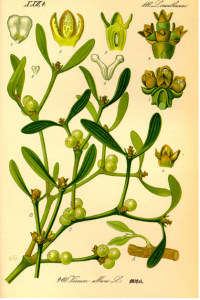Mistletoe is one of those plants that we only think about during the holiday season. The tradition is, if caught beneath a bough of mistletoe with another, you are supposed to kiss. After each kiss, a berry is to be plucked off the bough, when no berries remain the kissing ends.
After some exploration around this holiday decoration (and tradition) I discovered a bit about it’s history and it’s very interesting botanical attributes.
 |
| Viscum album (European Mistletoe) up close |
Often confused with holly (the type with red berries and sharply toothed glossy leaves), mistletoe is likewise an evergreen plant, but has white berries and rounded foliage.
From a botanical perspective, mistletoe is interesting in that it never roots in soil, it roots itself into the bark of a tree and gathers water and nutrients from it’s host. The leaves do provide for photosynthesis and growth of the plant, once established, but without it’s host it can not survive. It typically doesn’t kill the host tree but during times of drought, when the partially parasitic mistletoe is drawing water, the host tree can become stressed.
Most often found on deciduous trees, you can see the evergreen mistletoe plant most clearly once the host tree’s leaves have fallen.
 |
| Mistletoe in a host tree |
The kissing ball most resembles the natural shape of mistletoe, and has become another traditional holiday decoration. With a bit more artistic license then the simple bough of evergreens, kissing balls are made of all types of materials and may or may not include mistletoe. Regardless of the material used, you still get to smooch under a kissing ball.
 |
| Holiday Kissing Ball |
The folklore of mistletoe comes from old European mythology. As an evergreen plant, it was associated with life and fertility. It was also thought, by some cultures, to ward off evil spirits. In Scandinavia the plant was associated with peace, and if unfriendly parties met under a bough of mistletoe, they were to lay down their arms. It seems likely that the whole kissing business is rooted in these associations with fertility and peace.
 |
| Beautiful botanical print of Mistletoe Viscum album, by Thome |
So, to add some fun to your holiday decorating program, add some mistletoe (and/or) kissing balls to your home, and know they have a long association with luck, peace, and yes, even romance.



